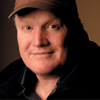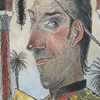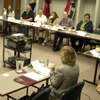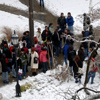|
||
      |
Letters: Apparently Chicago economists don’t live in the United States...
Blue-collar background but...
 Blue-collar economics says, “Do I have a secure job, do I have health
insurance and retirement benefits, is my company expanding, and are we
increasing our workforce?” University of Chicago economics asks, “Is
the GNP increasing?”
Blue-collar economics says, “Do I have a secure job, do I have health
insurance and retirement benefits, is my company expanding, and are we
increasing our workforce?” University of Chicago economics asks, “Is
the GNP increasing?”
Economist Kevin Murphy (“Murphy’s Law,” Nov–Dec/06) looks at the wrong end of the horse and ties “growth in wage inequality to growth in the demand for skilled labor.” Exactly backward. The drop in blue-collar wages is due to free trade. For the past two decades the difference between the median and the mean wage has risen in the United States. In short, the wages of the rich have increased because they own stock in now globalized companies employing slave labor in China, rather than employing high-wage American blue-collar workers.
There is no reason why blue- and white-collar raises could not rise in parallel. In fact, the great accomplishment of the United States was to raise the wages of the working class to world-envied heights. This was through the protected-economy policies of Alexander Hamilton.
What Mr. Murphy ignores is that the free-trade theories so actively promoted by Milton Friedman, AM’33, and the University started the great decline in the living standards of American workers. Apparently, Chicago economists don’t live in the United States or care about its citizens. Rather, they live in a “global world village,” whose drive is to equalize wages (except for professors’ salaries) across the world.
Mr. Murphy’s definition of genius is to come up with a solution that no average smart person would imagine. Hardly so. Genius is the ability to define what the problem is.
In the United States there is a crippling trade deficit, a massive decline in the number of Americans in manufacturing jobs, and millions of illegal immigrants affecting wages and living standards. We pick up the phone for our credit-card company and speak to someone in India, blue-collar wages are declining, white-collar wages are stagnant, and about half of African Americans without a college degree are unemployed.
And Mr. Murphy is writing about “Cattle Cycles”?
Paul Streitz, MBA’71
Darien, Connecticut
Safety first
I am convinced Professor Murphy is a brilliant thinker, but as someone who was in industry for many decades, I don’t think he has heard about safety, or else the photograph (page 36) was poorly posed. No one should ever be running any power tool, especially a saw, without safety goggles. I would also say that his left hand is at risk, although that is hard to judge. Safety may not be a very hot topic among Chicago professors, but they ignore it at their risk.
Werner Zimmt, PhB’47, SB’47, SM’49,
PhD’51
Tucson, Arizona
Shrinking photo ops
 I appreciated Susan M. Bielstein’s article (“Photo
Op,” Nov–Dec/06)
about copyright issues in the academic world. There is a real crisis confronting
all of us who critique and interpret our culture and society, not only
in the academy but in all areas of public discourse. I’m a documentary
filmmaker who has seen our ability to use the fair-use provision of the
copyright law shrink and all but disappear over the last 20 years. Like
Ms. Bielstein, I am also a copyright holder, and I must ensure that when
other creators use my images I am compensated fairly and the material is
not misused.
I appreciated Susan M. Bielstein’s article (“Photo
Op,” Nov–Dec/06)
about copyright issues in the academic world. There is a real crisis confronting
all of us who critique and interpret our culture and society, not only
in the academy but in all areas of public discourse. I’m a documentary
filmmaker who has seen our ability to use the fair-use provision of the
copyright law shrink and all but disappear over the last 20 years. Like
Ms. Bielstein, I am also a copyright holder, and I must ensure that when
other creators use my images I am compensated fairly and the material is
not misused.
The recent publication of the Documentary Filmmakers’ Statement of Best Practices In Fair Use by the Center for Social Media and the Washington College of Law at American University is an encouraging development in our field. This statement came out of meetings of documentary filmmakers across the country to restate our view of fair use. It is endorsed by the major organizations that represent documentary filmmakers as well as key legal scholars. My understanding is that there are similar movements in other disciplines to reclaim this space that is so important to open dialogue in our democracy.
Gordon Quinn, AB’65
Chicago
Is the real Antonello a click away?
I found the “Photo Op” piece amusing and interesting. I wonder, however, whether the reproduction now easily available on the Internet is the object of the failed search. If so, it would have been worthwhile to have reproduced it (assuming you could get permission to do so!) with the story of its actual provenance and its actual current location. Use Google: antonello + madonna and child, and you will get it instantly, in the collection of the National Gallery of Art.
Henry Ploegstra, AM’62, PhD’66
Dallas
Press editor Susan Bielstein replies: No, the National Gallery of Art work is not the mysterious Antonello. (I wish it were.) In fact, this turned out to be a rumor (there are many such floating around) without specific foundation. The hunt for the lost masterpiece really did turn out to be an object lesson on the dangers of wishful thinking—first by the author of the book I was editing, and then by me.
Solid scholarship
 The article on Hamlet (“Chicago
Journal,” Nov–Dec/06)
started with a disturbing faux pas or possibly malapropism: “Oh that
this too too sullied flesh.” David Grene, who lectured to
us on Hamlet when I was a freshman, would be turning handsprings
wherever he might be these days. The real word from the Bard is “solid,” not “sullied.” For
shame that the editor did not pick that up.
The article on Hamlet (“Chicago
Journal,” Nov–Dec/06)
started with a disturbing faux pas or possibly malapropism: “Oh that
this too too sullied flesh.” David Grene, who lectured to
us on Hamlet when I was a freshman, would be turning handsprings
wherever he might be these days. The real word from the Bard is “solid,” not “sullied.” For
shame that the editor did not pick that up.
In the same issue’s “Letters” column, the reference to the pipes of the Rockefeller Chapel organ made me remember, quite fondly, listening to E. Power Biggs play that magnificent instrument back in the spring of 1946, when he performed the complete Bach toccatas and fugues. The chapel was usually filled to capacity, so the music was “piped” out to the lawn where the rest of us listened to the divine music under the stars. The mild evenings made heaven palpable as we were transported there on those grand notes.
Charlotte Glauser, PhB’47, SB’47
Philadelphia
David Bevington, the Phyllis Fay Horton distinguished service professor emeritus in the humanities and the editor of the version of Hamlet used in the Great Books program, responds: The choice of “solid” (the Folio reading) or “sallied” (the second quarto reading) or “sullied” (the emendation adopted by many editors) is complex and much debated. The Folio reading makes sense, and is certainly a defensible choice, but most editors agree in preferring the second quarto of 1604–05 as generally a better text and closer to what Shakespeare may have written. Yet “sallied” seems puzzling; it could easily be a misprint or transmission error for “sullied.” (“A” and “u” are often virtually indistinguishable in early modern handwriting, or, indeed, today.) Hence the choice of many editors.
David Grene was a lovely man and a great teacher, but he was not an editor, and he was given to forthright statements. His preference for “solid” is entirely defensible. But it is unfair and, I think, misinformed to suppose that the choice of “sullied” is something to be ashamed of, particularly given that spellings in early English printed texts are predominantly the choice of compositors or scribes, not of the author. Shakespeare did not see his plays through the press.
There are literally thousands of emendations in the Shakespeare texts we read today; not all are defensible, but many are.
In the swim
 I received my AB and MD from the U of C. Met my husband in a physics lab
on campus. Did a year of residency at Wyler and gave birth to my first
two children at Lying-In—so I am grateful to the University for a
lot. But I will forever also be grateful to the administration for forcing
me to learn how to swim (“Tested
Waters,” Nov–Dec/06).
I received my AB and MD from the U of C. Met my husband in a physics lab
on campus. Did a year of residency at Wyler and gave birth to my first
two children at Lying-In—so I am grateful to the University for a
lot. But I will forever also be grateful to the administration for forcing
me to learn how to swim (“Tested
Waters,” Nov–Dec/06).
I did not know how to swim when I arrived on campus and signed up for the swimming course. But that winter was especially cold, and I missed a lot of classes. So what was I to do when told I would not be allowed to start second-year if I could not pass that infamous test? That summer I became a counselor for 3- to 5-year-olds at a day camp in my hometown and dutifully learned to swim along with my adorable charges.
Kudos to Chicago for keeping the swimming requirement intact. Now I swim several times a week near my home in southern Israel, and, of course, my children learned how to swim before they entered first grade—not university!
Renee Szabo Band, AB’70, MD’74
Omer, Israel
The life of the child
Thank you for publishing “The Root of the Problem” (“Investigations,” Nov–Dec/06). I’ve studied the child-welfare system since I was an undergrad at the U of C, where I worked as an assistant for the Child Protective Services team at the children’s hospital. Over the course of my studies as both an analyst for the federal government and now as a doctoral student, I’ve focused much of my attention on assessing performance of child-welfare agencies. I gratefully appreciate the attention on the positive efforts many scholars are doing to help improve the child-welfare system. Too often when a tragedy occurs, people start pointing fingers and blaming others for the failures, or they drastically try to overhaul policies in an attempt to solve the problem.
Professor Rzepnicki’s work using root-cause analysis to detail the decisions and actions throughout the course of the child’s case is a much-needed effort to bring the attention back to the particular circumstances that affected the life of the child and how the child-welfare system reacted to those circumstances. While most of the attention on the effectiveness of child-welfare systems focuses on achieving performance measures based on an entire state’s caseload, it is important not to forget the impact of individual cases. A critical review of what policies, practices, and individual factors may have affected the child throughout the case may yield much more useful information for child-welfare agencies when trying to learn how a past tragedy can prevent more in the future. I only wish more scholars and agencies throughout the country could adopt this root-cause analysis approach to not only learn from a child’s death, but to learn from those cases that have been successful as well.
Elizabeth Caplick, AB’00
Raleigh, North Carolina
More Court memories
The original outdoor theater 1958–60 was memorable (“Letters,” Nov–Dec/06). The best Iago I ever saw was Andy Duncan. He was brilliant. In real life he could skewer people by just asking seemingly innocent questions until they revealed their core.
My favorite Christmas Eve involved Mike Nichols, X’53, being carried in the back of Severn Darden, X’50, as Tiny Tim. The sketch was hilarious. So was another sketch about a man who dies ignominiously in a can factory (I think he got his head caught) and the embarrassment of his family at the funeral. Grand times. Great talents brewing.
Nancy Freed Kovitz, SB’60
Glencoe, Illinois
In defense of a lifelong liberal
Robert Reynolds of Tucson (“Letters,” Nov–Dec/06) is certainly a conservative. Connie Hogarth is not a remnant of anything. She has been alive and well in Westchester County for at least 40 years while New York liberals and radicals joined and supported her work as the director of the important center in White Plains. She has simply become a living icon for a large population of Americans just as her friend, Pete Seeger, continues to be a leader in folk music and politics. (And, yes, Corliss Lamont held the annual benefit for her center at his estate; the area has a long tradition of leftist politics and is now a bastion of the Democratic Party.) During my family’s 30 years in Westchester, both Connie and Pete were beloved figures in the community.
While Mr. Reynolds is entitled to be a Chicago mossback (or whatever such people are called), he should keep a civil tongue in his head when discussing our friends who reflect an older history (with connections to Jane Addams) now long lost at the University of Chicago.
Joanne Spencer Kantrowitz, PhD’67
Chicago
More on the Chicago Review
The interesting article on the Chicago Review’s 60th anniversary (“Arts & Letters,” October/06) set me reminiscing. During the fall quarter of 1949, some undergraduates felt they had no outlet for their literary work in the Chicago Review because it was closely guarded by graduate students in the English Department. In the spring of 1950, we published a little pamphlet entitled Opus (Vol. 1, No. 1), which we peddled throughout the dormitories and sold at a table outside the Commons dining area. We covered expenses, but it was not a venture we were able to continue past the first issue.
In the fall of 1951, having received my AB, I sought out the offices of the Chicago Review, thinking that I might offer my services in some capacity or other. The door on the third floor of the Reynolds Club was locked, and no one knew when the office was open. I persuaded the director of the Reynolds Club, Bill Birenbaum, JD’49 (later to be president of Antioch College), to give me a key. When I opened the door to the office I was confronted with piles of unopened mail, some submitted manuscripts, and some letters from libraries complaining about nondelivery of back issues. Then there were the cartons of copies of the most recent printing of the Review sitting in the back room.
I rounded up a few students, and we tried to fill the back orders and at the same time begin to put together material for a new issue. Chip Karmatz, AM’56, was instrumental in lining up advertising revenue, Neva van Peski provided absolutely vital office help, and Stanley Rosen, now a professor of philosophy at Boston University, was essential to restoring the poetry section. Then Frank Kermode came to my rescue by taking over the editorship. Once the Review got past that little blip it was well on its way.
Morton L. Schagrin, AB’51, SB’52, AM’53
Watertown, Massachusetts
Did you hear Hannah Arendt?
Just over 50 years ago, in April 1956, the political theorist Hannah Arendt delivered a series of six Walgreen Lectures on the “Vita Activa” in Social Science 122. As part of my research into the development of Arendt’s thought in the period leading up to the 1958 publication of The Human Condition, I would welcome the opportunity to communicate with any alumni who attended her Walgreen Lectures. I may be reached at the Department of Political Science, University of Chicago, 5828 South University Avenue, Chicago IL 60637, or by e-mail at p-markell@uchicago.edu.
Patchen Markell
Associate Professor of Political Science
Memories of Turabian
This spring the University of Chicago Press will publish a seventh edition of the much-beloved (and occasionally bemoaned) “bible” of the dissertation office: Kate L. Turabian’s Manual for Writers of Research Papers, Theses, and Dissertations.
The dissertation secretary at Chicago for decades, Turabian literally wrote the book on the successful completion and submission of the student paper. Her Manual, created from years of experience with research projects across all fields, has sold millions of copies since it was first published more than 70 years ago. The University of Chicago Press is asking Chicago alumni to share their memories of this authoritative dissertation guide and of Turabian herself. Please submit your stories—inspirational, painful, or otherwise—to lea@press.uchicago.edu.
Laura Andersen
The University of Chicago Press
Proud to be maroon
Again I was reminded of why I value my U of C experience and degrees. At the National Lawyers Conference, The Federalist Society, Richard A. Epstein and Geoffrey H. Stone, JD’71, two professors in the Law School, defended the rights of individuals as described in the United States Constitution. Like them, I believe in all of the Constitution, including the Bill of Rights. Thank you, sirs.
James A. Rogerson, AM’69, PhD’80
Charlotte, North Carolina
Department of Corrections
The “Research We Use” section of “Argonne Almanac” (Nov–Dec/06) mangled two lab accomplishments: The USS Nautilus, the world’s first nuclear-powered submarine, got its power from a nuclear reactor built by the Westinghouse Corporation at Argonne National Laboratory–West, while the lab’s Experimental Breeder Reactor II (EBR-II)—not the Boiling Water Reactor, BORAX-3—was the prototype for many commercial nuclear-energy plants.
In “Open House with Hamlet” (“Chicago Journal,” Nov–Dec/06), the Basic Program chair’s name should have read Clare Pearson. In the same issue (“Cultural Studies,” page 78), the Oriental Institute’s carved reliefs from Khorsabad were mislocated: the reliefs are in the Yelda Family Khorsabad Court of the OI Museum. We regret the errors.
The Magazine welcomes letters for publication, which must be signed and may be edited. To provide a range of views and voices, we ask writers to limit themselves to 300 words or less. Write: Editor, University of Chicago Magazine, 5801 S. Ellis Avenue, Chicago, IL 60637. Or e-mail: uchicago-magazine@uchicago.edu.